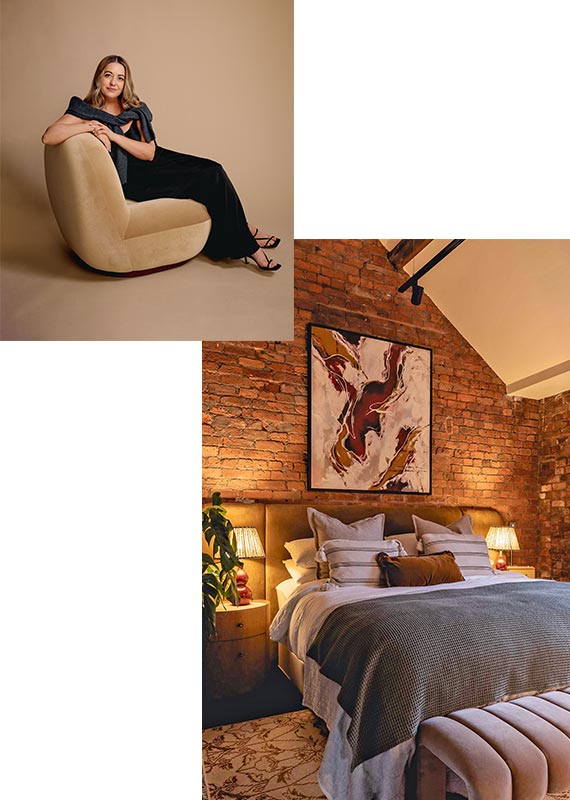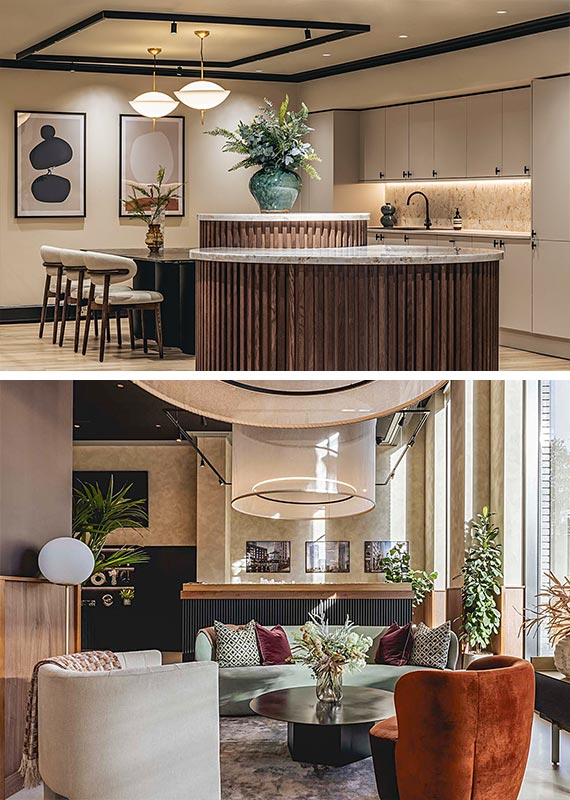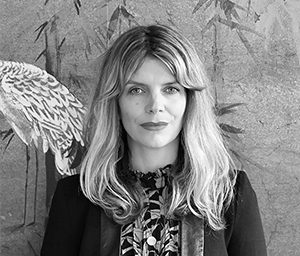What is sensory design?
It’s about creating spaces that don’t just look good but make you feel something. It’s a design approach that taps into all five senses: sight, sound, smell, taste, and touch, to build environments that people emotionally connect with and instinctively remember. At, we call this Immersive Aesthetics. It’s where thoughtful design meets human experience. We don’t just choose colours and materials because they’re beautiful, we choose them because they trigger a feeling, shift a mood, or spark a memory. We consider the acoustics of a room, the texture of a surface, the scent in the air, and how they all come together to shape the atmosphere.
 Jolie’s approach to interior design is to combine materials, colours, fragrances and sounds to imagine each interior and create immersive, multi-sensory experiences
Jolie’s approach to interior design is to combine materials, colours, fragrances and sounds to imagine each interior and create immersive, multi-sensory experiences
How do you put it into practice?
We work with researchers in neuroscience, psychology, sound, and scent to understand how the brain responds to its environment. Then we layer in the emotional, intuitive side of design, of how a space makes you feel, how it supports wellbeing, how it tells a story. It’s about designing with intent by using every sense to quietly influence behaviour, stir emotion, and create places that people love to be in. We want to design memorable spaces that go far beyond trends and truly stand the test of time.
Tell us about working with Sarah Wakefield (Jolie’s creative director and former head interior designer at Soho House)
Sarah was someone I had my eye on from the very beginning and I just knew I wanted her on the team. And paths finally aligned, it felt incredibly natural, like the timing was just right. She has this boundless, infectious creative energy, and honestly, she’s probably the most creatively free person I’ve ever met. I’m a deeply creative thinker too, but my lens has always been dual: one eye on design, the other firmly on the commercial and operational side of things. That’s where we’re such a strong match. Sarah lives and breathes design for the pure love of it, while I’m always thinking about how to shape creativity into something scalable and strategic.

How has becoming a new mother influenced your approach to interior design?
It has completely shifted the way I think about space! There’s a new layer of sensitivity and a real appreciation for how environments can feel both beautiful and truly liveable, even with little ones running around. It’s made me deeply consider the practicalities: hardy, wipe-clean surfaces, materials that can withstand daily life but without ever compromising on that elevated, luxurious feel… I’ve become a lot more intentional with the flow of a space too, creating little anchored zones, with precious pieces placed higher up where they’re actually better celebrated at eyeline, and keeping the lower levels robust and resilient. I love the idea of layering spaces, creating little pockets that are sacred and calm, perhaps even off-limits because it’s important to still have those grown-up sanctuaries.
If you could design your ideal personal retreat, what textures, colours and fragrances would you choose?
Thinking about the chapter I’m in, it would be all about calm, quietude, and gentle creative ignition. A place that lets you completely switch off from the white noise of life – but still feels deeply connected to culture and inspiration. I’m endlessly drawn to that Mediterranean softness; those chalky, sun-washed tones of pale clay, olive, and worn limestone. There’s something deeply comforting in materials that feel lived-in, honest, with layers of history in their essence. I’d lean into textures like matte plaster, soft vegan leather, and artisan-woven linens that almost whisper when you brush past them. And I’d frame it all with those quiet little luxe touches such as Milanese marble edging, hand- glazed ceramic tiles, maybe even a slightly offbeat Pierre Frey pillow on the bed to give it that little wink of personality.
The atmosphere would be scented with warm, grounding notes such as patchouli, sandalwood and amber, cut through with brighter top notes like bergamot and wild rosemary. I love anything herbaceous that reminds you of wandering through an open-air market somewhere coastal. And for sound, I’d curate a barely-there Ibiza chill-out playlist, something from the ’90s, nostalgic and effortless, like the soundtrack to a slow summer afternoon.
We want to design memorable spaces that go beyond trends and stand the test of time

Tell me about the role of sustainability at Jolie.
It isn’t just a buzzword for us, it’s in the very DNA of what we do. We take a holistic approach, considering the broader picture of sustainable design. We’re all about supporting ESG (Environmental, Social, Governance) and Ecology agendas, while also building ‘social sustainability’ into our work. Our aim is to create spaces that don’t just look good but give back to the community and last for the long haul.
And we go the extra mile by choosing suppliers with solid sustainability credentials, while pushing the envelope on social sustainability with smart design choices. It’s not just about the walls and floors, it’s about how the space works for people. Ultimately, we design with community in mind.
What’s next for the studio?
We’re at a seriously exciting moment in the Jolie journey. This year, we’re gearing up to move into a much bigger London space, which not only gives us more room to grow, but lets us shape an environment that fully reflects our energy, our scale, and the ambition behind where we’re going next. We’re also laying down roots in New York, with plans to officially open our US base in the Meatpacking District later this year. We’ve already started working on a few incredible projects over there, but having our own physical space in the city is going to be a real game- changer. It marks the beginning of Jolie operating formally out of the States, which feels like a very natural next step for the brand.

